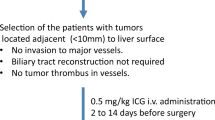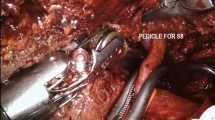Abstract
Laparoscopic liver resection (LLR) is now widely used as a minimally invasive surgical option for benign and malignant liver disease. Recent advances in LLR technique and instrumentation have enabled various procedures, including anatomic resection in liver surgery. However, the endoscopic approach is limited by its two-dimensional view, the absence of tactile sense, and the difficulty in establishing anatomic orientation, due to the use of a magnified view. Indocyanine green (ICG) fluorescence imaging is a tool for real-time surgical navigation in hepatobiliary surgery. It is useful in identifying anatomic portal parenchymal territory, localizing liver tumors, and detecting bile leakage during open liver surgery. With the development of laparoscopic fluorescence imaging systems, this technology can now be used for LLR. As LLR is increasingly adopted for treatment of liver disease, uptake of intraoperative real-time image guidance systems is likely to accelerate. The ICG fluorescence imaging system will be helpful as a surgical “third eye” in ensuring safe and precise LLR.
Access this chapter
Tax calculation will be finalised at checkout
Purchases are for personal use only
Similar content being viewed by others
References
Makuuchi M, Hasegawa H, Yamazaki S (1985) Ultrasonically guided subsegmentectomy. Surg Gynecol Obstet 161:346–350
Lamade W, Vetter M, Hassenpflug P, Thorn M, Meinzer HP, Herfarth C (2002) Navigation and image-guided HBP surgery: a review and preview. J Hepatobiliary Pancreat Surg 9:592–599
Wigmore SJ, Redhead DN, Yan XJ et al (2001) Virtual hepatic resection using three-dimensional reconstruction of helical computed tomography angioportograms. Ann Surg 233:221–226
Beller S, Hunerbein M, Eulenstein S, Lange T, Schlag PM (2007) Feasibility of navigated resection of liver tumors using multiplanar visualization of intraoperative 3-dimensional ultrasound data. Ann Surg 246:288–294
Reich H, McGlynn F, DeCaprio J, Budin R (1991) Laparoscopic excision of benign liver lesions. Obstet Gynecol 78:956–958
Kaneko H, Takagi S, Shiba T (1996) Laparoscopic partial hepatectomy and left lateral segmentectomy: technique and results of a clinical series. Surgery 120:468–475
Kaneko H, Takagi S, Otsuka Y, Tsuchiya M, Tamura A, Katagiri T et al (2005) Laparoscopic liver resection of hepatocellular carcinoma. Am J Surg 189:190–194
Troyan SL, Kianzad V, Gibbs-Strauss SL, Gioux S, Matsui A, Oketokoun R, Ngo L, Khamene A, Azar F, Frangioni JV (2009) The FLARE intraoperative near-infrared fluorescence imaging system: a first-in-human clinical trial in breast cancer sentinel lymph node mapping. Ann Surg Oncol 16:2943–2952
Tajima Y, Yamazaki K, Masuda Y, Kato M, Yasuda D, Aoki T, Kato T, Murakami M, Miwa M, Kusano M (2009) Sentinel node mapping guided by indocyanine green fluorescence imaging in gastric cancer. Ann Surg 249:58–62
Rubens FD, Ruel M, Fremes SE (2002) A new and simplified method for coronary and graft imaging during CABG. Heart Surg Forum 5:141–144
Unno N, Suzuki M, Yamamoto N et al (2008) Indocyanine green fluorescence angiography for intraoperative assessment of blood flow: a feasibility study. Eur J Vasc Endovasc Surg 35:205–207
Aoki T, Yasuda D, Shimizu Y, Odaira M, Niiya T, Kusano T, Mitamura K, Hayashi K, Murai N, Koizumi T, Kato H, Enami Y, Kusano M (2008) Image-guided liver mapping using fluorescence navigation system with indocyanine green for anatomical hepatic resection. World J Surg 32:1763–1767
Ishizawa T, Fukushima N, Shibahara J, Masuda K, Tamura S, Aoki T et al (2009) Real-time identification of liver cancers by using indocyanine green fluorescent imaging. Cancer 115:2491–2504
Kaibori M, Ishizaki M, Matsui K, Kwon AH (2011) Intraoperative indocyanine green fluorescent imaging for prevention of bile leakage after hepatic resection. Surgery 150:91–98
Sakaguchi T, Suzuki A, Unno N, Morita Y, Oishi K, Fukumoto K, Inaba K, Suzuki M, Tanaka H, Sagara D, Suzuki S, Nakamura S, Konno H (2010) Bile leak test by indocyanine green fluorescence images after hepatectomy. Am J Surg 200(1):e19–e23
Hasegawa K, Kokudo N, Imamura H, Matsuyama Y, Aoki T, Minagawa M, Sano K, Sugawara Y, Takayama T, Makuuchi M (2005) Prognostic impact of anatomic resection for hepatocellular carcinoma. Ann Surg 242:252–259
Takayama T, Makuuchi M, Watanabe K, Kosuge T, Takayasu K, Yamazaki S et al (1991) A new method for mapping hepatic subsegment: counterstaining identification technique. Surgery 109:226–229
Aoki T, Murakami M, Yasuda D, Shimizu Y, Kusano T, Matsuda K, Niiya T, Kato H, Murai N, Otsuka K, Kusano M, Kato T (2010) Intraoperative fluorescent imaging using indocyanine green for liver mapping and cholangiography. J Hepatobiliary Pancreat Sci 17:590–594
Sakoda M, Ueno S, Iino S, Hiwatashi K, Minami K, Kawasaki Y, Kurahara H, Mataki Y, Maemura K, Uenosono Y, Shinchi H, Natsugoe S (2014) Anatomical laparoscopic hepatectomy for hepatocellular carcinoma using indocyanine green fluorescence imaging. J Laparoendosc Adv Surg Tech A 24(12):878–882
Yamamoto M, Takasaki K, Ohtsubo T, Katsuragawa H, Fukuda C, Katagiri S (2001) Effectiveness of systematized hepatectomy with Glisson’s pedicle transection at the hepatic hilus for small nodular hepatocellular carcinoma: retrospective analysis. Surgery 130:443–448
Uchiyama K, Ueno M, Ozawa S, Kiriyama S, Shigekawa Y, Hirono S, Kawai M, Tani M, Yamaue H (2011) Combined intraoperative use of contrast-enhanced ultrasonography imaging using a sonazoid and fluorescence navigation system with indocyanine green during anatomical hepatectomy. Langenbecks Arch Surg 396:1101–1107
Satou S, Ishizawa T, Masuda K, Kaneko J, Aoki T, Sakamoto Y, Hasegawa K, Sugawara Y, Kokudo N (2013) Indocyanine green fluorescent imaging for detecting extrahepatic metastasis of hepatocellular carcinoma. J Gastroenterol 48:1136–1143
van der Vorst JR, Schaafsma BE, Hutteman M, Verbeek FP, Liefers GJ, Hartgrink HH et al (2013) Near-infrared fluorescence-guided resection of colorectal liver metastases. Cancer 119:3411–3418
Ishizawa T, Harada N, Muraoka A et al (2010) Scientific basis and clinical application of ICG fluorescence imaging: hepatobiliary cancer. Open Surg Oncol J 2:31–36
Kitao A, Zen Y, Matsui O et al (2010) Hepatocellular carcinoma: signal intensity at gadoxetic acid-enhanced MR Imaging–correlation with molecular transporters and histopathologic features. Radiology 256:817–826
Kudo H, Ishizawa T, Tani K, Harada N, Ichida A, Shimizu A, Kaneko J, Aoki T, Sakamoto Y, Sugawara Y, Hasegawa K, Kokudo N (2014) Visualization of subcapsular hepatic malignancy by indocyanine-green fluorescence imaging during laparoscopic hepatectomy. Surg Endosc 28:2504–2508
Morita Y, Sakaguchi Y, Unno N, Shibasaki Y, Suzuki A, Fukumoto K, Inaba K, Konno H (2013) Detection of hepatocellular carcinomas with near-infrared fluorescence imaging using indocyanine green: its usefulness and limitation. Int J Clin Oncol 18:232–241
Lin WR, Lim SN, Macdonald SA, Graham T, Wright VL, Peplow CL et al (2010) The histogenesis of regenerative nodules in human liver cirrhosis. Hepatology 51:1017–1026
Nakanuma Y (1995) Non-neoplastic nodular lesions in the liver. Pathol Int 45:7013–7714
Sathirakul K, Suzuki H, Yasuda K, Hanano M, Tagaya O, Horie T et al (1993) Kinetic analysis of hepatobiliary transport of organic anions in Eisai hyperbilirubinemic mutant rats. J Pharmacol Exp Ther 265:1301–1312
Tanaka T, Takatsuki M, Hidaka M, Hara T, Muraoka I, Soyama A, Adachi T, Kuroki T, Eguchi S (2014) Is a fluorescence navigation system with indocyanine green effective enough to detect liver malignancies? J Hepatobiliary Pancreat Sci 21:199–204
Lo CM, Fan ST, Liu CL et al (1998) Biliary complications after hepatic resection: risk factors, management, and outcome. Arch Surg 133:156–161
Yamashita Y, Hamatsu T, Rikimaru T et al (2001) Bile leakage after hepatic resection. Ann Surg 233:45–50
Ijichi M, Takayama T, Toyoda H et al (2000) Randomized trial of the usefulness of a bile leakage test during hepatic resection. Arch Surg 135:1395–1400
Lam CM, Lo CM, Liu CL et al (2001) Biliary complications during liver resection. World J Surg 25:1273–1276
Suehiro T, Shimada M, Kishikawa K et al (2005) In situ dye injection bile leakage test of the graft in living donor liver transplantation. Transplantation 80:1398–1401
Mulllock BM, Shaw LJ, Fitzharris B, Peppard J, Hamilton MJ, Simpson MT et al (1985) Sources of proteins in human bile. Gut 26:500–509
Ishizawa T, Tamura S, Masuda K, Aoki T, Hasegawa K, Imamura H et al (2009) Intraoperative fluorescent cholangiography using indocyanine green: a biliary road map for safe surgery. J Am Coll Surg 208:e1–e4
Cherrick GR, Stein SW, Leevy CM, Davidson CS (1960) Indocyanine green: observations on its physical properties, plasma decay, and hepatic extraction. J Clin Invest 39:592–600
Author information
Authors and Affiliations
Corresponding author
Editor information
Editors and Affiliations
Rights and permissions
Copyright information
© 2016 Springer Japan
About this chapter
Cite this chapter
Otsuka, Y., Kaneko, H. (2016). Usefulness of ICG Fluorescence Imaging in Laparoscopic Liver Resection. In: Kusano, M., Kokudo, N., Toi, M., Kaibori, M. (eds) ICG Fluorescence Imaging and Navigation Surgery. Springer, Tokyo. https://doi.org/10.1007/978-4-431-55528-5_37
Download citation
DOI: https://doi.org/10.1007/978-4-431-55528-5_37
Published:
Publisher Name: Springer, Tokyo
Print ISBN: 978-4-431-55527-8
Online ISBN: 978-4-431-55528-5
eBook Packages: MedicineMedicine (R0)




